The return of the FAWSL sees two of the league’s in-form teams play each other in what is expected to be a tight clash. Everton Women and Chelsea Women have both played some exceptional football having beaten some impressive teams with some swagger. Everton have amassed six wins and one draw including a thrashing at Aston Villa Women. Chelsea, on the other hand, have already beaten Manchester City Women and Arsenal Women in the league and cup competition. An impressive 9-0 win against Bristol City showed the attacking potential they have so how do the two teams stack up against each other for this tie?
This tactical analysis will analyse the finer tactical details between both teams and how they will play out against each other.
Predicted Lineups
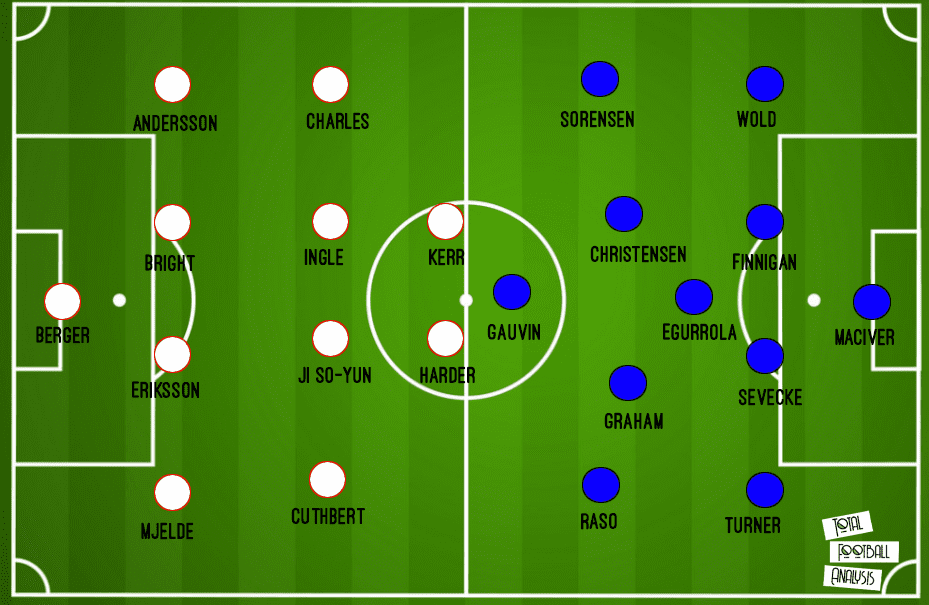
Chelsea Women should line up in their 4-4-2 formation which should give them firepower up front and width from the wide areas. The only change from their last league game against Manchester City will be enforced with Fran Kirby picking up an injury and be replaced by Guro Reiten. The rest of the team should be unchanged.
Everton Women should line up in their 4-1-4-1 formation to try and match Chelsea in midfield. The battle will be won and lost there so having enough numbers to match and balance attack and defence will be key.
Chelsea Women’s attacking tactics vs Everton Women’s low block
Chelsea have an identity playing quick, free-flowing football harnessing the attacking qualities of Sam Kerr and Pernille Harder. They’ve retained their 4-4-2 shape and system that served them well, however, there have been some adjustments this year to accommodate the newer players.
The Blues have alternated between the 4-4-2 and 4-1-3-2 system to adopt a more central attack approach whilst instructing their full-backs to become more involved in the final third. A feature of their play in 2019/20 was their ability to take advantage of the two wide players in Guro Reiten and Erin Cuthbert, who would both switch between crosses and cutting inside. After Kerr’s arrival in January 2020, they became even more unpredictable with the Australian’s ability to play as a focal point and deep-lying forward.
This year, the addition of Harder and return of Fran Kirby has posed a tactical issue and though the same shape has been used, Hayes has Chelsea playing a lot more centrally which has brought the best out of Kirby who has been able to influence play. Everton are likely to defend in a 4-1-4-1 high press dropping into a mid-block as Chelsea advance and will be more active in pressing. The crowded central areas will mean the full-backs will become much more important here to provide width and overload Everton’s defenders.
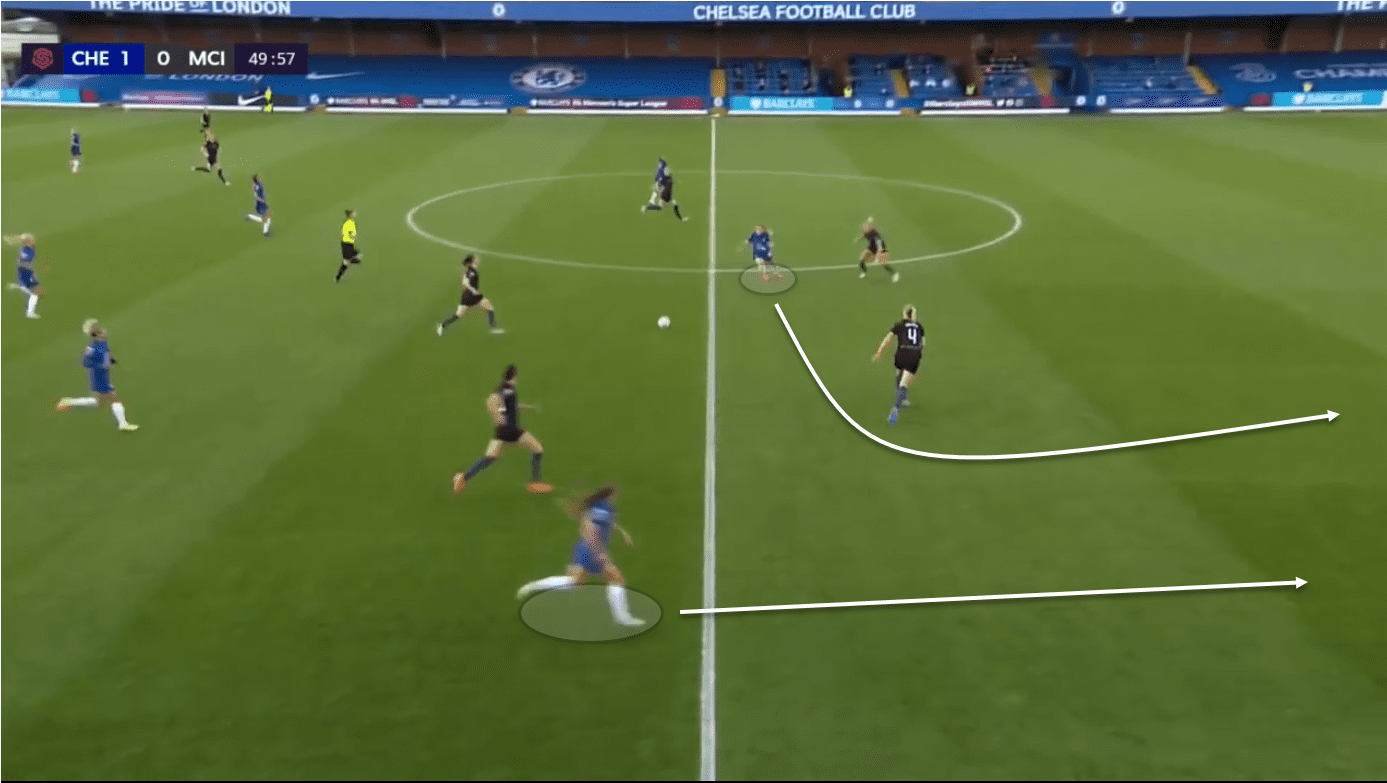
Chelsea will want to get into positions against Everton’s full-backs to create space in behind them through passes between the centre-back and full-back as is seen above. Chelsea’s emphasis will be to overload the half-space and bring players around to play quick, attacking football. Passing the ball quickly and using third man runs will be essential in breaking down a resolute Everton side. Chelsea’s best player this season in Kirby has been vital to their playmaking in these wide areas and her absence will be felt. However, the inclusion of Niamh Charles can be seen as a positive with the former Liverpool attacker a potentially capable replacement.
It was evident against Manchester City Women where they were able to take advantage of the space in behind the wide areas given how high the full-backs were. Kerr’s goal came from a quick breakaway but it came from an outside pass to Kirby from Cuthbert where she was able to square it across for Kerr. In contrast, against Birmingham City, Chelsea struggled in the first half when they came up against a low-block team determined to keep a tight shape.
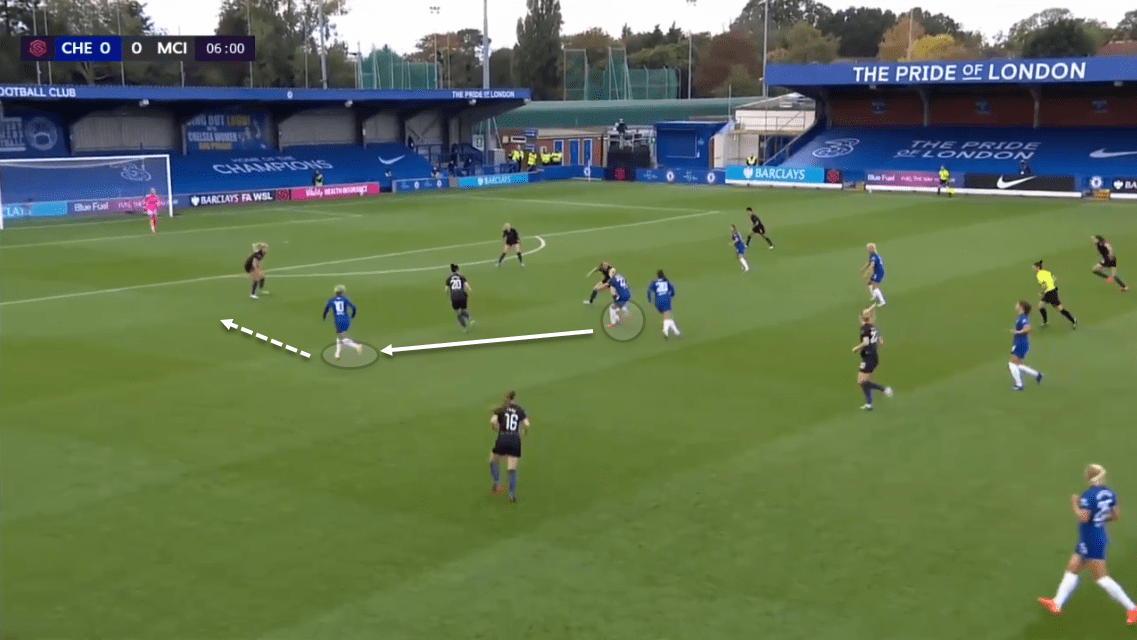
Chelsea’s solution was to make the pitch wider by bringing in players who will keep the width and possibly cut inside closer to the box. The image above shows one such example where Chelsea have packed the central areas with the wide areas left alone. Cuthbert’s pass to Ji sees her come back inside but what it does is ensure the left side is open.
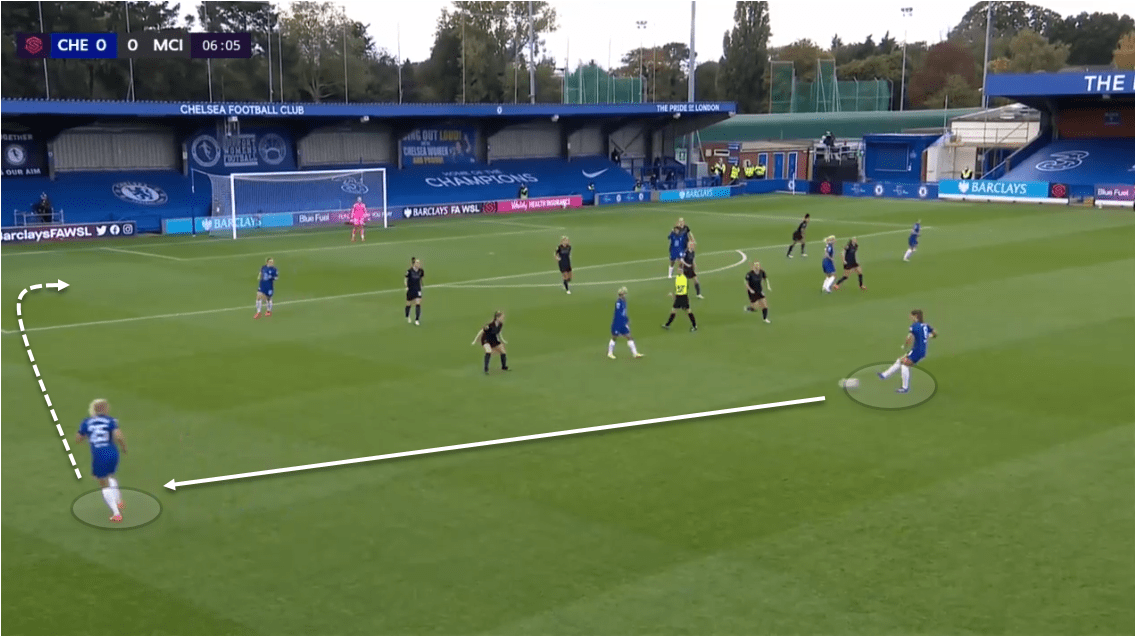
Once Ji faces a blockade, the ball is passed back to Melanie Leupolz who finally releases a pass to Jonna Andersson who exploits the space here. From here, she’s able to move forward and cross for the central players. Though this opportunity was blocked, Chelsea were able to find a way past a team playing compact football.
If we look at the pass map against Everton from earlier in the season, you’ll notice how the final third is very centre focused with the full-backs (#25 & #18) being the widest players on the pitch. While they are encouraged to get forward, it’s to help facilitate the chances to open up spaces here.
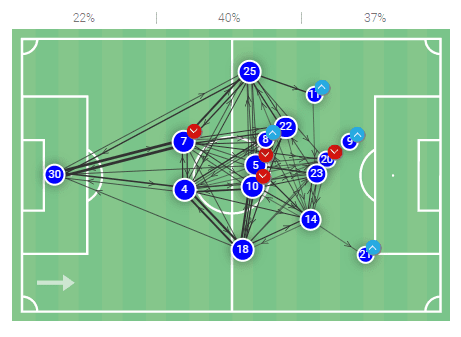
Everton’s 4-4-2 mid-block will see their wingers drop in to help out the full-backs and will want to keep Chelsea’s wingers quiet. Everton have adopted a much more rigid system against the higher quality sides and adopt an aggressive pressing style the closer teams get to the box. Willie Kirk is wary of the quality the top three teams pose and against Manchester City did the same.
The below image shows their structure sees them shift players close by to stop passing lanes and overpower players. As we’ve alluded to earlier, they’ll attempt to create double-ups where they have control over where the ball goes. Nicoline Sørensen and Hayley Raso tracked back diligently against Manchester City in the F.A Cup final.
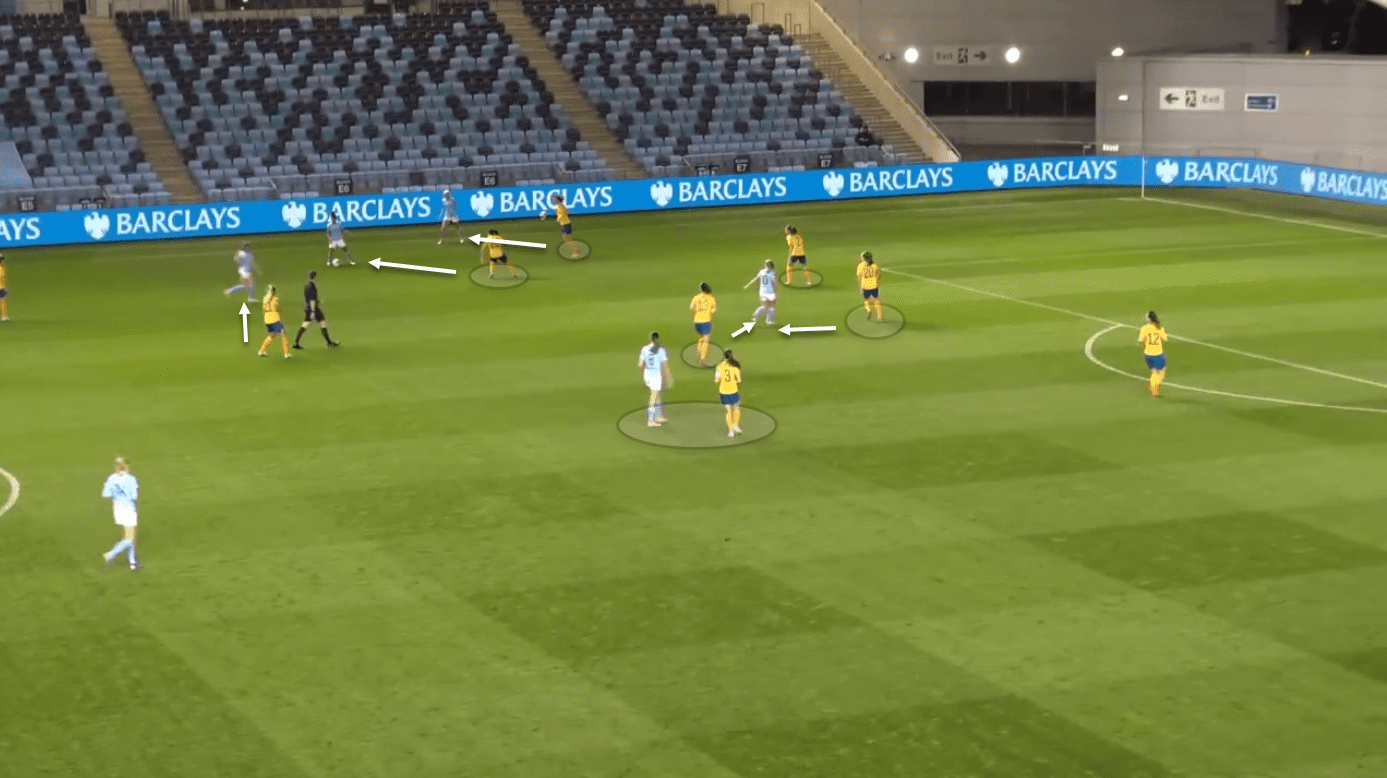
Combined with this, we’ll expect them to press Chelsea aggressively in midfield and force them back. Any long balls played in should be dealt with if they hold a low enough line. There were times against City where they lost out aerially and it allowed City to counter-attack and score from a cross. It’ll be crucial to keep Chelsea passive in midfield and stop them from passing freely because the Melanie Leupolz/Ji double-axis has the capabilities of playing acute, penetrative passes.
The image below shows Manchester City Women patiently playing around Everton but manage to get the ball to Rose Lavelle who plays a quick through ball into the box which yields a shooting chance.
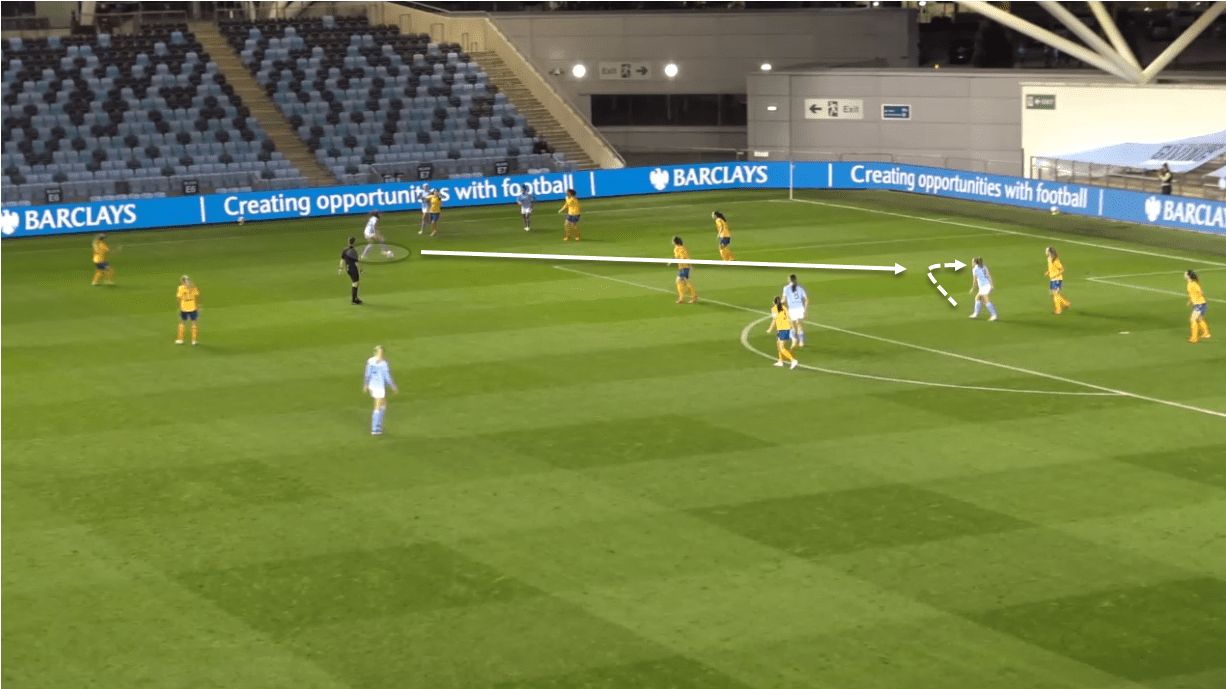
Build-up through Leupolz and Ji so-Yun will be key in penetrating the first line of press with their active passing and ball carrying abilities. Leupolz has been an alternative to Sophie Ingle at the base of midfield and has been equally if not better with her passing range and calmness on the ball. Everton will need to keep the pair controlled if they want to have a semblance of hope in winning the midfield battle.
How will Everton deal with Chelsea’s defensive tactics?
Tactically, that’ll be where Chelsea will have to be wary of Everton’s attacking structure and principles. This season, Kirk’s side have found a formula that works and the acquisition of new attackers has prompted a more structured way of attacking. Everton Women have a unique build-up structure where they have the single-pivot drop-in which triggers the two centre-backs to split wide to create a three-person build-up option. Lining up in a 4-3-3, their aim is to push the full-backs up and have the wingers stationed on the outside of the opposition full-backs to receive balls and play in this region. They want to create crossing opportunities for the likes of Valerie Gauvin to attack.
There are two methods in which they get the ball into the wingers/full-backs. The first is through the use of their focal point in Gauvin where she plays with her back to goal holding up the ball and laying it off for her teammates making runs in behind. Whether it be the wingers cutting inside or overlapping full-backs, Gauvin has been excellent at finding these spaces for Everton and has been one of the main reasons for their attacking prowess as is seen in the below image.
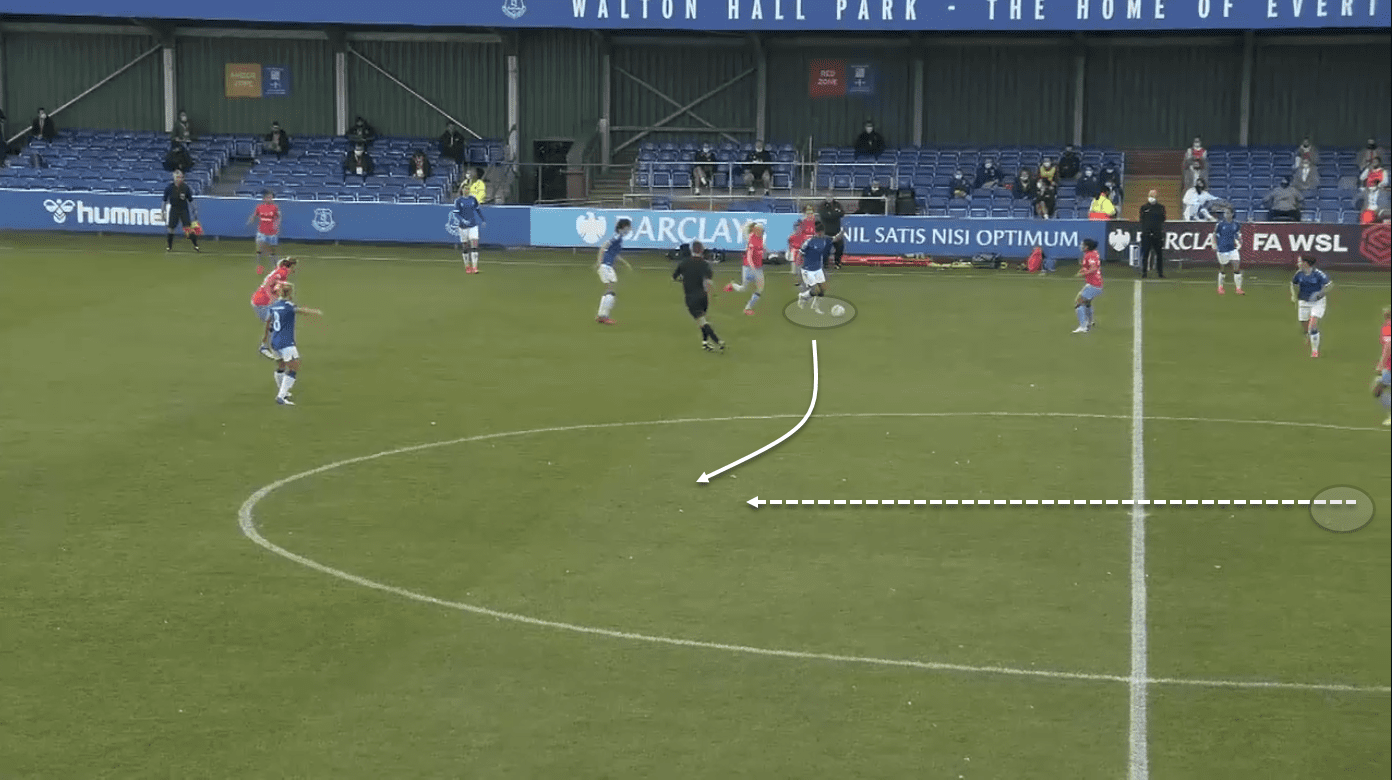
Gauvin has dropped into midfield to collect possession and has taken the attention of two West Ham United Women players with her. The idea here is to play a pass square across and make her way back up front.
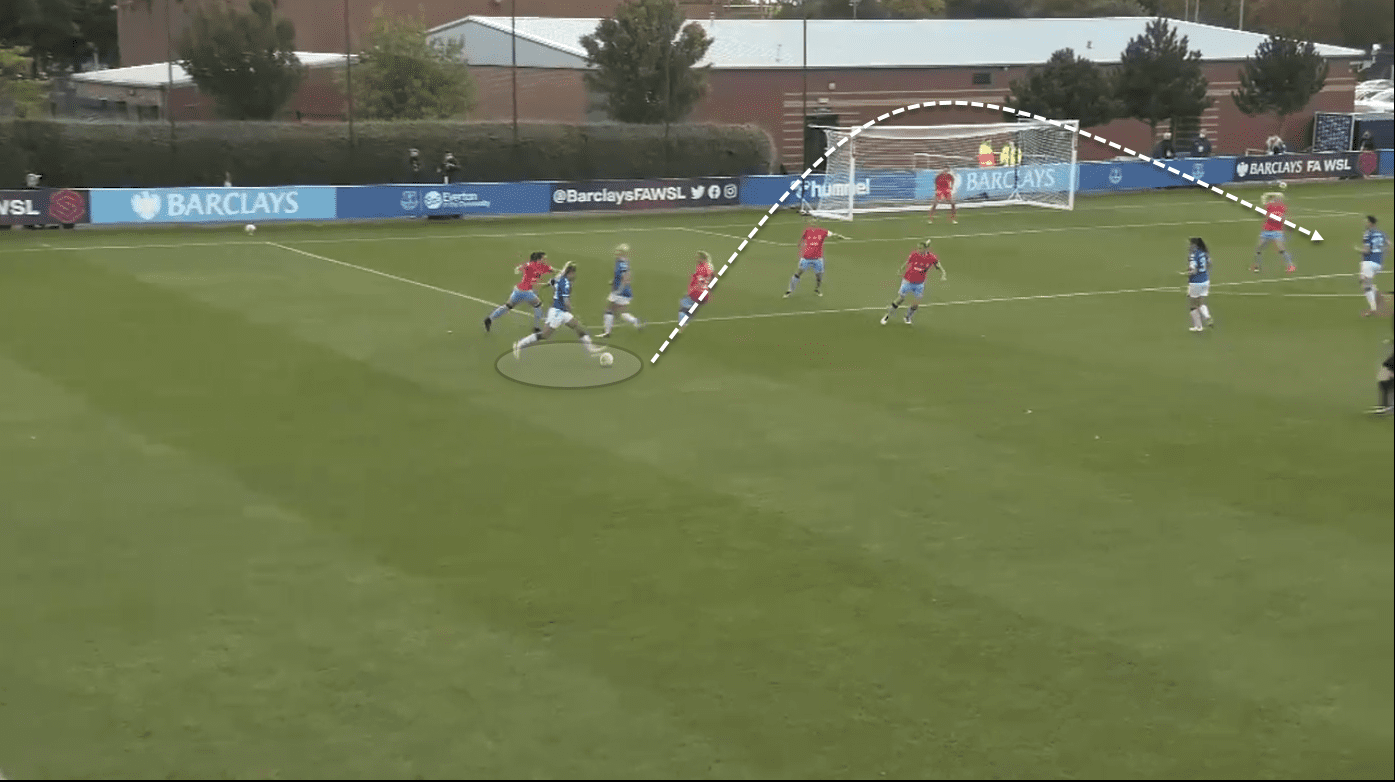
The ball being at left-wing is a result of Gauvin’s previous run into midfield. The runner took the ball forward and quickly passed it to Claire Emslie who has now attracted almost four West Ham players to her side. The cross into the box allows Gauvin to make a late run and attempt a header. This patient, yet effective build-up and attacking method can affect Chelsea. They have pace and trickery in Sorensen and Raso who can pin Maren Mjelde and Andersson back and force them to stay back, though they themselves will be tasked with marking them defensively. Up against the midfield duo of Leupolz and Ji, Gauvin’s strength may cause them a few issues and force Chelsea to play a more compact game needing a centre-back to step up or drop one of the pivots deeper and play the more defensive-minded Ingle.
To take advantage of the space Gauvin creates, Izzy Christensen has made a lot of attacking runs in behind. A lot of what Everton have done this season is use the combination of Gauvin and Christensen which makes them slightly unpredictable. If Gauvin and the two wingers can occupy the defenders, then Christensen’s runs could become very dangerous. It’ll require the defenders and defensive midfielder to be positionally aware of these runs and track where players are going. Though, it will come down to picking out the right passes for Everton which was evident in their FA Cup final showing. They failed to find Gauvin on a number of occasions and just gave away possession. With the pace Chelsea have, they do not want to be in a situation where they’re left exposed on the counter-attack.
However, it is important to note that against Manchester City, Everton struggled to contain them at times. Manchester City were able to bypass Everton’s heavy press and compact shape through a combination of quick, attacking football and constantly moving attackers. These movements in the wide areas especially allowed City to find gaps to play penetrative passes which is also a strength amongst the Chelsea ranks. Ji, Cuthbert, Kerr, and Harder will need to play incisive football in the final third to break down this Everton defence. As we alluded to already, they struggled to break down Birmingham City’s defence and a change in tactics but switching from a single focal point to two and encouraged the wide players to play closer to the two strikers. If Everton are slow in closing down Chelsea’s attackers they could face similar issues again.
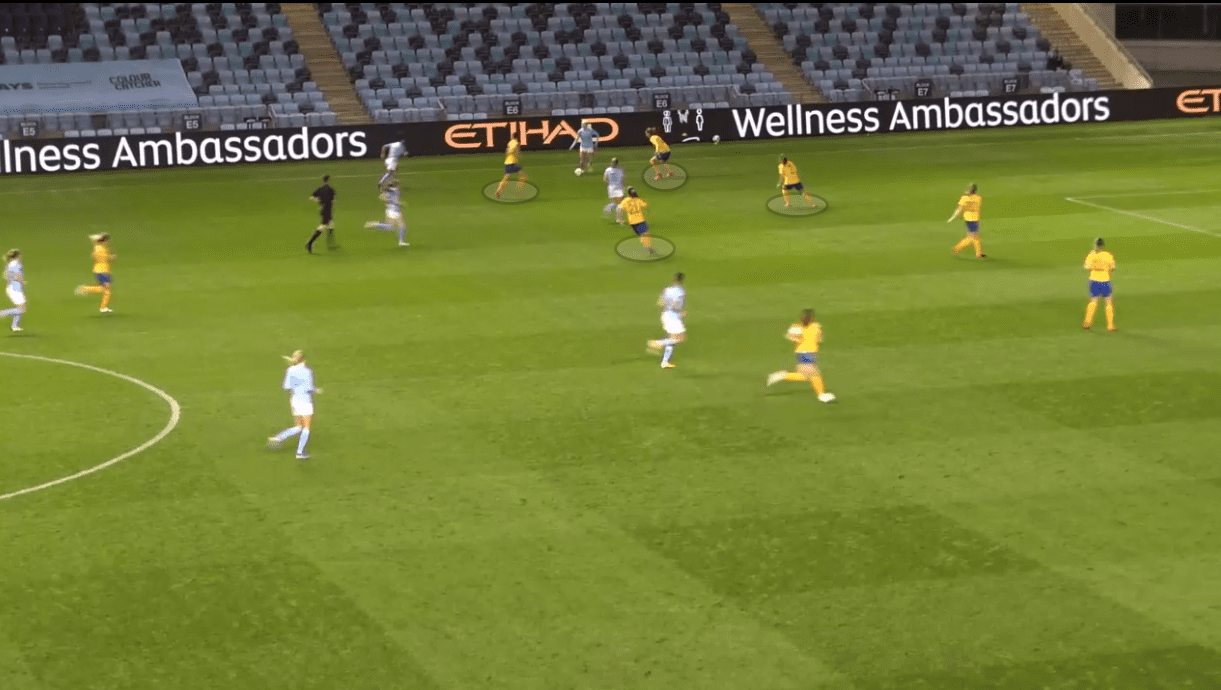
The above image shows Everton pressing and closing Manchester City in numbers creating a square-like shape to close down one attacker. However, the City winger is able to play a quick pass through the two defenders for the free player to run in behind and attack. Chelsea have similar quality in their ranks and Everton have to be tighter and more disciplined in these areas.
Chelsea won’t just sit back and let Everton have possession when Everton try to build out from the back. The Blues will continue to use the pressing tactics that have served them well throughout the season. Their attackers have often been cornering players in the wide areas to win it back and play in the furthest forward player. They often do this in a systematic way by not letting the ball carrier sit in possession for too long and every pass is met with a player going to recover and pressure the ball. Just as the image below portrays, you see Harder pressing the Arsenal midfielder with Reiten in support. If the ball is passed back then Reiten will move across and press the next player. This could be critical for Chelsea given Everton’s struggles in playing under duress having given away possession a few times this way this season.
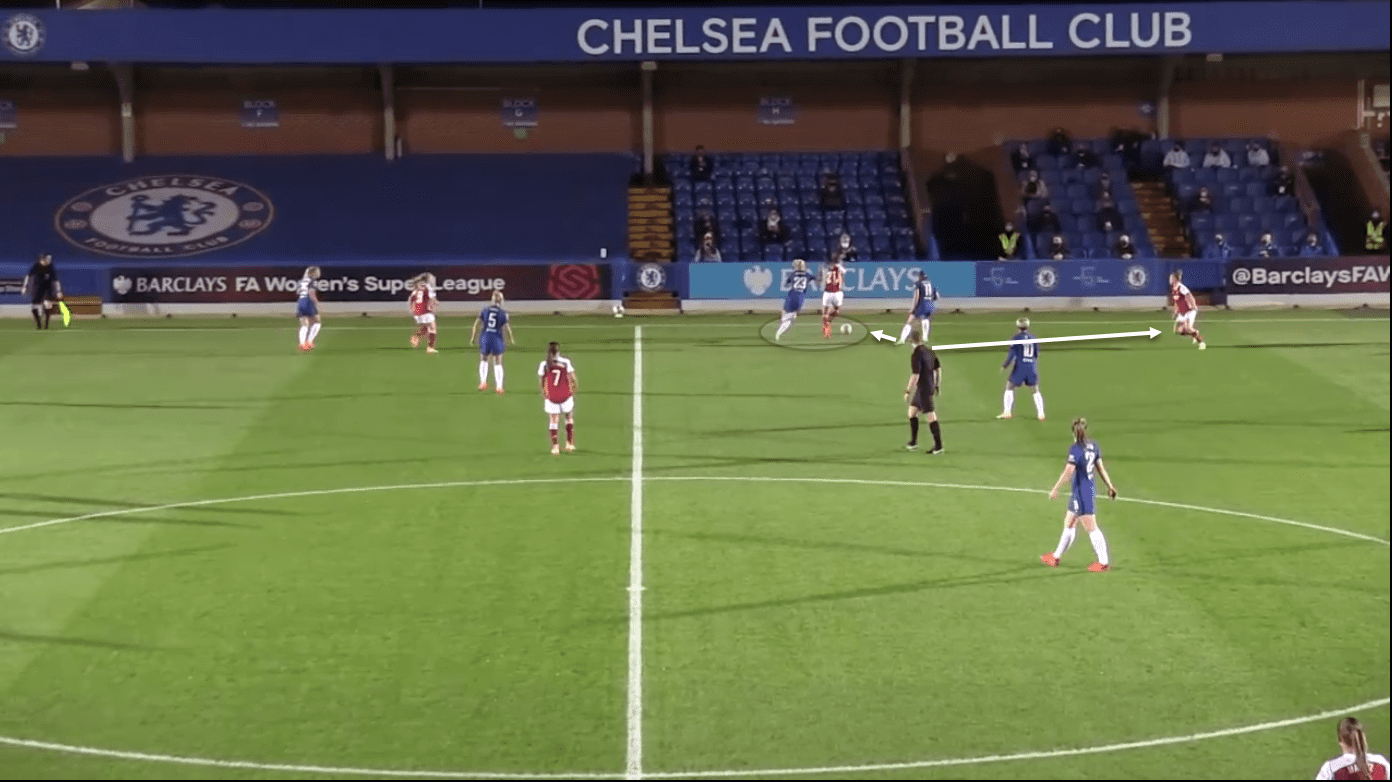
Final remarks
Tactically, it’ll be interesting to see how Kirk will cope with Chelsea’s talented attacking quadrant. Stopping the likes of Kerr and Harder will be of utmost importance given their abilities in playmaking and goalscoring. The loss of Kirby will be a huge boost for Everton given she’s arguably been Chelsea’s best player this season but they have more than enough firepower to cause attacking problems. Chelsea should still come out on top with a 3-1 win.





Comments